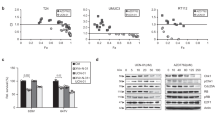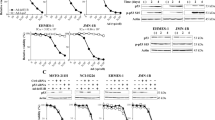Abstract
Cultured primary human cells have been widely used to assess the selectivity of oncolytic viruses as potential anticancer agents. As culture conditions can potentially have a significant impact on virus replication and ultimately cell killing, we evaluated the effects of dl309, a wild-type adenovirus, and dl01 / 07, a conditionally replicating adenovirus mutant, on quiescent and proliferating primary mammary epithelial cells. When primary cells were induced into quiescence, both viruses exhibited similar attenuated cell killing. However, cell killing by dl309 was superior to dl01 / 07 in proliferating primary cells. Analysis of viral effects at the level of entry, E2F activation, DNA replication, and late gene expression indicated that attenuation of dl309 in quiescent cells correlated with decreased expression of viral late genes such as hexon. In contrast, attenuation of dl01 / 07 in quiescent cells correlated with inefficient induction of E2F activity and inability to undergo efficient DNA replication. In proliferating cells, dl309 replicated efficiently, whereas dl01 / 07 still showed attenuated replication. In summary, our results indicate the intrinsic preference of wild-type adenoviruses for killing proliferating cells, which is an attractive feature for using adenoviruses as oncolytic agents. These results also highlight the need for the use of appropriate growth conditions for primary cells in vitro to distinguish subtle differences in cell killing among various oncolytic viruses.
This is a preview of subscription content, access via your institution
Access options
Subscribe to this journal
Receive 12 print issues and online access
$259.00 per year
only $21.58 per issue
Buy this article
- Purchase on Springer Link
- Instant access to full article PDF
Prices may be subject to local taxes which are calculated during checkout








Similar content being viewed by others
References
Howe JA, Demers GW, Johnson DE, et al. Evaluation of E1-mutant adenoviruses as conditionally replicating agents for cancer therapy. Mol Ther. 2000;2:485–495.
Ramachandra M, Rahman A, Zou A, et al. Re-engineering adenovirus regulatory pathways to enhance oncolytic specificity and efficacy. Nat Biotechnol. 2001;19:1035–1041.
Kirn D . Clinical research results with dl1520 (Onyx-015), a replication-selective adenovirus for the treatment of cancer: what have we learned? Gene Therapy. 2001;8:89–98.
Heise C, Hermiston T, Johnson L, et al. An adenovirus E1A mutant that demonstrates potent and selective systemic anti-tumoral efficacy. Nat Med. 2000;6:1134–1139.
Alemany R, Balague C, Curiel DT . Replicative adenoviruses for cancer therapy. Nat Biotechnol. 2000;18:723–727.
Jones N, Shenk T . An adenovirus type 5 early gene function regulates expression of other early viral genes. Proc Natl Acad Sci USA. 1979;76:3665–3669.
de Martin R, Raidl M, Hofer E, Binder BR . Adenovirus-mediated expression of green fluorescent protein. Gene Therapy. 1997;4:493–495.
Huyghe BG, Liu X, Sutjipto S, et al. Purification of a type 5 recombinant adenovirus encoding human p53 by column chromatography. Hum Gene Ther. 1995;6:1403–1416.
Shabram PW, Giroux DD, Goudreau AM, et al. Analytical anion-exchange HPLC of recombinant type-5 adenoviral particles. Hum Gene Ther. 1997;8:453–465.
Atencio IA, Ramachandra M, Shabram P, Demers GW . Calpain inhibitor 1 activates p53-dependent apoptosis in tumor cell lines. Cell Growth Differ. 2000;11:247–253.
Wen SF, Xie L, McDonald M, et al. Development and validation of sensitive assays to quantitate gene expression after p53 gene therapy and paclitaxel chemotherapy using in vivo dosing in tumor xenograft models. Cancer Gene Ther. 2000;7:1469–1480.
Doronin K, Toth K, Kuppuswamy M, et al. Tumor-specific, replication-competent adenovirus vectors overexpressing the adenovirus death protein. J Virol. 2000;74:6147–6155.
Brightwell G, Poirier V, Cole E, et al. Serum-dependent and cell cycle-dependent expression from a cytomegalovirus-based mammalian expression vector. Gene. 1997;194:115–123.
Brantley DM, Chen CL, Muraoka RS, et al. Nuclear factor-kappaB (NF-kappaB) regulates proliferation and branching in mouse mammary epithelium. Mol Cell Biol. 2001;12:1445–1455.
Sherr CJ . Cancer cell cycles. Science. 1996;274:1672–1677.
Branton P . Early gene expression. In: Seth P, ed. Adenoviruses: Basic Biology to Gene Therapy. Austin, TX: RG Landes; 1999: 33–58.
Doronin K, Toth K, Kuppuswamy M, et al. Overexpression of the ADP (E3-11.6K) protein increases cell lysis and spread of adenovirus. Virology. 2003;305:378–387.
Tollefson AE, Scaria A, Hermiston TW, et al. The adenovirus death protein (E3-11.6K) is required at very late stages of infection for efficient cell lysis and release of adenovirus from infected cells. J Virol. 1996;70:2296–2306.
Dobbelstein M . Replicating adenoviruses in cancer therapy. Curr Top Microbiol Immunol. 2004;273:291–334.
Smith RR, Huebner RJ, Rowe WP, et al. Studies on the use of viruses in the treatment of carcinoma of the cervix. Cancer. 1956;9:1211–1218.
Acknowledgements
We thank Drs Dan Maneval, Bill Demers, Robert Ralston, and Shu Fen Wen for helpful discussion and Dr Suganto Sutjipto and Doug Cornell for virus production and purification.
Author information
Authors and Affiliations
Corresponding author
Rights and permissions
About this article
Cite this article
Vaillancourt, M., Atencio, I., Quijano, E. et al. Inefficient killing of quiescent human epithelial cells by replicating adenoviruses: potential implications for their use as oncolytic agents. Cancer Gene Ther 12, 691–698 (2005). https://doi.org/10.1038/sj.cgt.7700840
Received:
Published:
Issue Date:
DOI: https://doi.org/10.1038/sj.cgt.7700840
Keywords
This article is cited by
-
A fully replication-competent adenovirus vector with enhanced oncolytic properties
Cancer Gene Therapy (2010)



